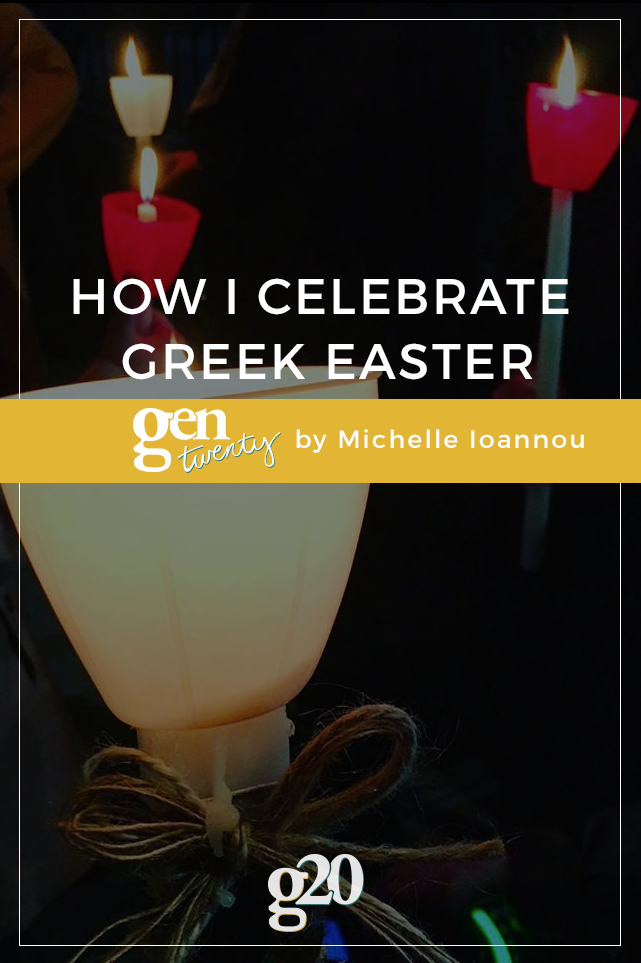I grew up knowing that the week before Easter, if I were to open up the fridge in my grandparents’ basement, there will be lamb legs tied together there to welcome me.
Yes, we roast an entire lamb on a spit in our yard. Unlike in My Big Fat Greek Wedding, we have the spit in our backyard rather than our front yard, but that’s pretty much the only difference.
Greek Easter is my favorite holiday of the year, and there’s a lot of reasons for that.
Here’s a glimpse into how I celebrate Greek Easter:
1. Holy Week is one of the most beautiful weeks of the year.
Whereas some of my friends would go away during Spring Break back when I was a teenager, I would be spending the week in church. From Palm Sunday up until Easter, there’s services every day, and they’re all beautiful. Many joke that this is “Greek fashion week” as it’s the week that everyone is in church looking their best — regardless of whether they go regularly throughout the year or not.
2. The Good Friday Procession
Good Friday is the most solemn day of Holy Week, but it ends in a beautiful way. Churches everywhere hold a Epitaph procession in the streets, with all parishioners, priests, clergy, holding lit handles, chanting special hymns. Growing up in New York City, my church actually closes down two major streets to hold this procession. Seeing people watching from the restaurants we pass by and while stopped in their cars never fails either.
3. The midnight Anastasi Service
On late Saturday night, everyone goes to church, again with candles. Some people stay inside the church whereas other people go outside of the church. Regardless of whether you’re inside or outside, just before midnight, we receive “the light” from the priest — representing the light of God.
The priest then reads the passage from the Bible, telling the story of the Resurrection. Once this reading is over, usually at midnight, the priest exclaims “Χριστὸς ἀνέστη!” which means “Christ is risen!” Everyone then replies saying “Ἀληθῶς ἀνέστη!” which means “Truly He is risen!” This is also around the time that you can start feeling your cell phone in your pocket start vibrating as all your friends and relatives start texting “Χριστὸς ἀνέστη!” to each other.
4. Breaking the fast.
We don’t just give up one thing for Lent — we’re not supposed to have meat, dairy, or oil during Lent in preparation of Easter. Because of this, you can imagine how glorious it is to break the fast! After the midnight Easter service, everyone goes to eat their favorite meals — mine is usually a toss up between a diner cheeseburger or Taco Bell, much to my grandmother’s dismay. The actual tradition is to gather at someone’s house and eat Magiritsa Soup, which is made from the offal of the lamb that you are going to eat later that day.
5. Lamb on a spit.
“My family is big and loud, but they’re my family. We fight and we laugh, and yes, we roast lamb on a spit in the front yard.” No sentence describes my family and life better than this sentence from My Big Fat Greek Wedding. Well, it’s a toss up between this line and “What do you mean, he don’t eat no meat? That’s okay, that’s okay. I make lamb.” It’s not Easter unless there’s lamb in some way shape or form. It’s my favorite tradition, it smells glorious, and it tastes delicious.
6. Red eggs.
You know as a child when you would dye eggs all fun colors and decorate them? Yeah, Greeks don’t, at least not traditionally. We dye our eggs completely red. Bright red. Why? Because the red color represents the blood of Jesus. The egg represents the empty rock at the tomb where Jesus emerged.

We then don’t just eat these eggs, we play a game. Each person chooses an egg and hits the other person’s egg. Whoever’s egg does not crack is the winner, and has to go on to find someone else whose egg did not crack. The person whose egg stays intact wins, and gets all of the bragging rights. Some say that this person is then supposed to have good luck.
7. Tsoureki
This is essentially our Easter sweet bread. Tsoureki is a sweet bread that is made with flour, butter, eggs, milk and other ingredients. This is all then braided into a loaf that comes out rich, fluffy, and delicious. A red egg is typically put into the middle of the tsoureki, and quite frequently tsoureki is part of your breaking the fast meal. Traditionally, the tsoureki is made on Holy Thursday.
8. Discount Easter candy and decorations.
Greek Easter tends to always be after when everyone else celebrates Easter. This means we get to take advantage of all of the Easter sales that happen after Easter has already happened. It’s perfect for us to make Easter baskets for our children and godchildren or want just some extra candy and decorations.
9. Godparents make Easter baskets for their godchildren.
Not just any Easter basket though — godparents are responsible for buying their godchildren a Lambada, which is a beautifully decorated Easter candle that the child then lights at either the midnight service or the morning service on Easter. These candles can be decorated in any way, and you can easily choose one that fits your godchild perfectly.
This is just a quick glimpse at some of our Greek Easter traditions and celebrations. Words truly cannot do it justice, though. If you ever have the opportunity to experience Greek Easter, both the day of celebration and the church services, I highly encourage you to do so. Immerse yourself in it, and you’ll be grateful to have experienced it.

